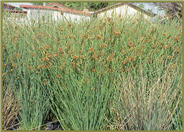
Common name:Western Redbud
Botanical name:Cercis occidentalis
This deciduous shrub ranges from 6-20 ft. tall and 10-15 ft. wide. It is desirable for its magenta spring flowers, yellow to red fall color, and dangling winter seed pods. It is tolerant of many soil types, drought and oak root fungus. It attracts hummingbirds and butterflies. The Western Redbud can be found statewide in California in the foothills below 4500 ft. elevations in chaparral and woodland communities
- Cornflower Farms

Common name:Elijah Blue Fescue
Botanical name:Festuca 'Elijah Blue'
The 'Elijah Blue' is a dwarf, very glaucous variety with almost white foliage. It should receive sun and little summer watering. -Monterey Bay Nursrey

Common name:Coast Redwood
Botanical name:Sequoia sempervirens
This fast-growing, aromatic tree has soft, dark green foliage with long needles appearing in flat sprays and brown, barrel-shaped cones that appear after 1 year. Its soft, red-brown bark is fiberous and furrowed. Particularly after mechanical damage, this tree will stump sprout to form new, young trees around the stump. Avoid planting in areas of high foot traffic.

Common name:Strawberry Madrone, Marina Strawber
Botanical name:Arbutus 'Marina'
The 'Marina' has gorgeous bark, with leaves that are smaller and not as glossy as Pacific Madrone. Its flowers are pink, borne in pendant clusters in the summer. The fruit is large, red and quite ornamental. The plant should be grown in sun to part shade, with little or no summer watering when established. The 'Marina' prefers good drainage. -Monterey Bay Nursery

Common name:Purple Sage
Botanical name:Salvia leucophylla
The purple sage is an evergreen shrub that grows 2-3' tall by 5-6' wide. It has white tomentose stems and leaves and light purple flowers that bloom between May and June. This shrub tolerates heat and drought. The purple sage is a California native. -Cornflower Farms

Common name:Ivy Geranium
Botanical name:Pelargonium peltatum
Clouds of single flowers are produced from spring through fall on this plant, which should be planted in areas that receive part sun. -Monterey Bay Nursery

Common name:Howard McMinn Manzanita
Botanical name:Arctostaphylos densiflora 'Howard McMinn
This shrub is highly appreciated for its decorative characteristics, which include a dense show of small, pale pink, urn-shaped flowers. Above all, it is the mahogany-red to brown bark (which peels beautifully) that is the major attraction. Its fruit resembles the tike apple, and the flowers contrast perfectly to the light green leaf (which can get rather tough). It blooms from late winter to spring. - Cornflower Farms

Common name:Manzanita Emerald Carpet
Botanical name:Arctostaphylos 'Emerald Carpet'
The 'Emerald Carpet' is an evergreen groundcover that grows to 1' tall by 6-8' wide. It is favored by many landscapers as the manzanita of choice for inland situations. It has dark green leaves and exhibits compact growth. This variety is relatively tolerant of adverse soil conditions. -Monterey Bay Nursery

Common name:Red Buckwheat
Botanical name:Eriogonum grande rubescens
Red Buckwheat is a low growing woody perennial 1-2 ft high and 3 ft. wide. It has showy dark pink summer flowers that stand out against small gray-green foliage. It is a California native that is drought tolerant. It attracts butterflies and benefical insects. - Cornflower Farms

Common name:Quartz Creek Rush
Botanical name:Juncus effusus pac. 'Quartz Creek'
This selection of a vibrant green reed is widely used in landscapes due to its carefree nature and rigid upright structure. This Juncus initially grows very rapidily and then slows to eventually clump to 36" wide. It will reach a height of approximately 24-36". Reguires fairly regular water in the warmer months to perform well. Requires wet soils and lots of water. Use only in high water areas.
| Designer: Liz Ryan | Path to Forest |
Photographer: GardenSoft |
Soils and Compost:
Incorporate compost 6" into your soil to retain water, reduce compaction, feed earthworms, and provide valuable nutrients to your plants.
Water Saving Tip:
Eliminate runoff, especially with fixed spray sprinklers, clay soils, and slopes, by dividing the total watering time into shorter increments.
This allows water to soak in.
Integrated Pest Management:
Remove irrigation water and fertilizer from areas where you don't want weeds to grow.

